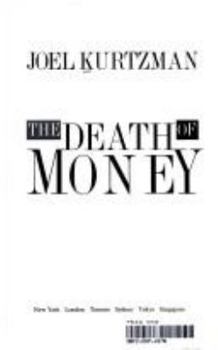The Death of Money: How the Electronic Economy Has Destabilized the World's Markets and Created Financial Chaos
Select Format
Select Condition 
Book Overview
In the tradition of Bankruptcy 1995, the executive editor of the Harvard Business Review demystifies the arcane world of international currency trading and shows how this 24-hour-a-day global... This description may be from another edition of this product.
Format:Hardcover
Language:English
ISBN:0671687999
ISBN13:9780671687991
Release Date:January 1993
Publisher:Simon & Schuster
Length:256 Pages
Weight:1.10 lbs.
Dimensions:0.9" x 9.6" x 6.5"
Customer Reviews
2 ratings
This book will wake you up to the new world of money and how it got to where it is today.
Published by Thriftbooks.com User , 16 years ago
This book filled in all the "holes" in my education in the area of money and economics. It gives a detailed history of the evolution of money from the beginning days when money had it's own intrinsic value, thru the moment when Nixon took the dollar off the gold standard to the present where money now exists as an abstraction, just numbers on a computer screen backed by nothing. The author distinguishes between the real economy and the financial economy, and how the financial economy created an interest driven, electronic economy that is now completely out of touch with the real economy, having a life of its own with no regard for human beings or anything else other than numbers and the financial well being of the people who know how to manipulate those numbers. He points out the social implications and destabilizing effects of this new money system on individuals, families, businesses, countries and on the future of our species. What is now required is a new level of integrity and trust. The level of integrity that was sufficient to operate in in the real economy of yesterday, is no longer sufficient for relating to, and operating within, the interest driven, electronic economy that is backed by agreement and trust alone. What I got out of reading this book is that money is no longer what I thought it was. I relate the new economy of money to driving a car. When we all got our driver's license, we agreed (in the US) to drive on the right side of the road. For the most part (with the exception of drunkenness etc) we all keep that agreement. Keeping that agreement creates a condition of workability. It allows for a consistent flow of traffic so that each of us can successfully reach our destination. We also trust that other drivers will keep their agreements about driving on the right side of the road, that "red" means stop and "green" means go etc etc. Driving is a system based on agreements and trust. Included in this system are strong consequences (laws) if people break their agreements. Driving on the left side of the road not only endangers lives, but also will lead to strict fines, loss of the privilege to drive and, perhaps jail time. This is a perfect analogy for the new economy. It is based solely on agreement and trust. The author points out that what's missing are: 1. consequences (stricter laws) for people who violate that trust and who break their agreements, and, 2. people waking up to how the new non-money economy works.This book is that wake-up call Although published in 1993, it is absolutely relevant today and into the future.
A wonderful explanation of the new, computerized financial system
Published by Thriftbooks.com User , 19 years ago
This book was written 11 years ago, so some of its information is dated, but its basic premise has only become stronger: that the nature of money has changed from a tangible medium of exchange (i.e., cash) into a complex and chaotic system of computerized balance sheets and numerical flows. The Federal Reserve estimates today that the entire worldwide supply of US money is currently about 10 trillion dollars ($10,000,000,000,000). This includes cash, savings accounts, checking accounts, money market funds, and other kinds of bank deposits. But only 700 billion (or 7%) of these dollars are paper cash dollars circulating outside of bank vaults, of the sort you can carry in your wallet. If everybody wanted to cash out their bank accounts at the same time, there simply wouldn't be enough paper dollars to go around. Banks would have to close temporarily while the Federal Reserve printed more cash. I don't know how long it would take to print 9 trillion more paper dollars ... let's see, the Bureau of Engraving and Printing typically prints $40 billion per year, so at current production levels it would take over 200 years to print all the cash required if everybody demanded all their cash at the same time. The kind of money you can hold in your hand is pretty much obsolete. Unless you are a drug dealer, you probably pay for most of your purchases with checks, credit cards, or debit cards. You might also pay for some of your purchases via automatic deductions or e-banking. This book vividly explains the complex, evolving, and essentially uncontrollable system underlying these non-cash forms of payment.





